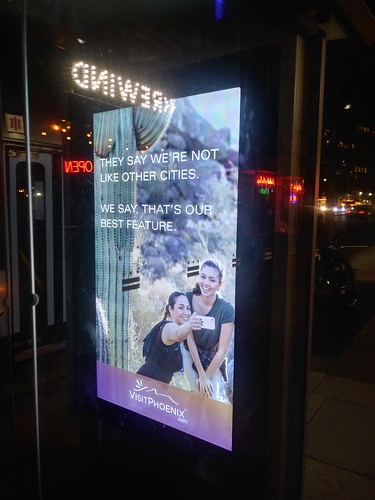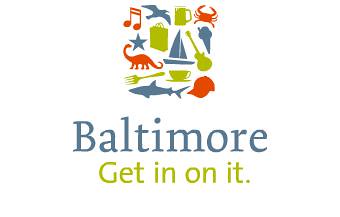City branding versus identity | Branding versus Urban Strategy
 They Say we're not like other cities. We Say that's our best feature. Visit Phoenix marketing promotion bus shelter ad, Washington, DC
They Say we're not like other cities. We Say that's our best feature. Visit Phoenix marketing promotion bus shelter ad, Washington, DCAaron Renn (Urbanophile/Manhattan Institute) has a piece out on CityLab, "Cities: Don’t Fall in the Branding Trap," getting a lot of play with its questioning of homogenized city branding and marketing initiatives. From the article:
It’s curious that while every company tries its hardest to convince you of how much different and better it is than every other company in its industry, every city tries its hardest to convince you it’s exactly the same as every other city that’s conventionally considered cool.
Look at any piece of city marketing material, from promo videos to airline magazine ad inserts. It’s amazing how so many of them rely on the same basic ingredients: hipster coffee shops, microbreweries, bike lanes, creative-class members, startups, intimations of a fashion scene, farm-to-table restaurants, new downtown streetcars, etc.
 In 2006, Baltimore's "Get in on it" branding campaign was widely derided.
In 2006, Baltimore's "Get in on it" branding campaign was widely derided.I have written about this issue for years--one of my earliest substantive posts from March 2005 is on the topic--"Town-City branding or 'We are all destination managers now'"-- and for a long time didn't even like to use the term "branding," because it comes out of the advertising world and seems to be counter to the ground up idea and concept of identity.
The point I made in that piece is that if we make places great "for us," usually they are attractive to others as well. (This built on a piece from 2002 when I made the point that people visiting the H Street area to go to a theater or the then Children's Museum could, by their spending, support a greater range of retail and restaurants than the neighborhood would otherwise be able to support on its own.)
This book isn't a textbook, more like a motivator to spark ideas about urban positioning and branding. It was authored by Julian Stubbs, one of the organizers of the city branding conference in Liverpool that I attended last June.
Later I became more comfortable with the term in some recommendations I wrote for plans I did in Brunswick, Georgia and Cambridge, Maryland, making the point that elected officials and key stakeholders within a community need to think of themselves as "brand managers." This is from the Cambridge plan:
Just as the study team believes that “we are all destination managers now,” elected and appointed officials in particular and in association with other community stakeholders serve as a community’s “brand managers”—whether or not they choose to think of their roles in this manner.Place-lessness in a DC Cool marketing ad.
That means that decision-making on land use and zoning, business issues, infrastructure development (roads, sewers, water, utilities, transit), technology (broadband Internet, etc.) and quality of place factors (arts, culture, historic preservation and heritage, education, public schools and libraries, etc.) must be consistent and focused on making the right decisions, the decisions that collectively achieve and support the realization of the community’s desired vision and positioning.
I agree with Aaron that too many communities aren't focused on the right things. I think it comes down to communities not being clear about their "competitive advantages."
-- "More (pathetic?) city branding efforts... (Baltimore)," 2006
-- "(DC) Neighborhoods and commercial districts as brands," 2012
-- "The taxi livery debacle as a lead in to a broader discussion of the importance of "design" to DC's "brand promise"," 2012
-- "Design as city branding: transit edition," 2012
-- "City (and university) branding: brand deposits; brand withdrawals; brand destruction," 2012
-- "Georgetown: A subtle but important difference between branding and identity-positioning," 2010
-- "Identity ≠ branding or Authenticity is the basis of identity," 2007
-- "Great concept, but I don't love the videos: Orlando's "Discover Your Urban" promotion campaign," 2017
-- "Some really good marketing videos that are models of city and/or transit promotion," 2018
-- "I don't get DC's visitor marketing ad campaign at all," 2015
It happens this came up in a discussion on a local e-list, HistoricWashington, when someone called attention to a post ("Breaking up DCRA isn’t enough — we need a deputy mayor for urban planning and enforcement") suggesting that DC needs a "Deputy Mayor for Planning," because in the current organizational set up where the city has a Deputy Mayor for Planning and Economic Development, planning gets subsumed to economic development.
I think the issue is a bit more complicated.
Operational responsibilities for economic development outweigh concern for planning. I don't know if I believe that a Deputy Mayor for Planning is needed. But definitely, hiring a Deputy Mayor who comes from planning is a way to change the way the position is conceptualized.
In an interesting switch, this DC Cool features historic architecture and name checks Georgetown.
But it's more than that. It isn't just that there is a Deputy Mayor position to whom a bunch of agencies report. It's that the DMPED office has a large "economic development" unit also managed by the Deputy Mayor, which is operational, pursuing and managing multiple projects.
From the standpoint of the line from the book In Search of Excellence, "what gets measured gets done," when the bulk of your job and operational responsibilities are economic development related, that's what you focus on.
The ED functions should be calved off and run by a director who isn't the Deputy Mayor. (And in many cities this is done by a third party nonprofit agency. That has issues too.)
Separately, creating a planning commission probably is in order too. There is so much going on planning and development wise in DC that having an extra stage of "independent" evaluation and review is in order and would help both the legislative and executive branches make better decisions.
Rollin Stanley
Planning versus Urban Strategy. When Canadian Rollin Stanley left as director of planning for Montgomery County, Maryland to a position in Calgary, I thought he took a position as director of planning and permitting, drawn in part by Calgary's hyper growth.
But that wasn't the case. Instead, he was hired by Mayor Naheed Nenshi, considered to be one of the most forward thinking mayors in North America ("Calgary Mayor makes us look like rednecks" and "'Canada's mayor' sees the city positively," Toronto Star), to be "Manager of Urban Strategy" ("Getting to Know Calgary General Manager Rollin Stanley," Skyrise Calgary).
Calgary has created an "Urban Strategy Studio," to be out in front of various real estate development and other initiatives, to:
help focus attention on strategic projects and the infrastructure necessary to make these initiatives happen. The outcomes are focused on making the right investment decisions that result in city building investments that benefit the city and ensure city resources are being located and used to their highest and best uses.Another example of placelessness in city marketing.
Start by figuring out your city's competitive advantages. For years and years and years I've written that DC has five competitive advantages:
1. Historic architecture;
2. Place-positive urban design/livability/walkable neighborhoods;
3. History, authenticity, and identity;
4. A rich transit infrastructure that allows for efficient mobility that is not dependent on the automobile;
5. The steady employment engine of the Federal Government.
From the standpoint of what I wrote vis a vis Cambridge and Brunswick, if those are your competitive advantages, then the decisions you make in terms of new development, infrastructure investments, marketing, business recruitment, etc., need to support those advantages by building on and extending them.
I've never really felt that was something embraced or understood by most of the city's elected and top appointed officials.
I wrote about this in 2005, in terms of DC's overly generous offer for a baseball stadium in "Maybe DC can learn that it has something that developers want," and "When you don't believe you're really "world class," you make bad deals," making the point that when you have a lot to offer you don't need to give away the store in negotiating.
This DC Lottery video highlighting city neighborhoods and places is a far better example of promoting the city's best attributes than much of the city's other marketing initiatives, and this ad isn't even focused on external audiences.

Books such as The Living City and Cities: Back from the Edge by Roberta Gratz, and Changing Places by Richard Moe are particularly good resources on the value of place and historic preservation as a sustainable urban revitalization strategy as is Economics of Uniqueness: Investing in Historic City Cores and Cultural Heritage Assets for Sustainable Development, published by the World Bank and freely downloadable.
Urban Strategy, identity, and competitive advantage versus branding and marketing. Along the lines of my "transformational projects action planning" concept ("Why can't the "Bilbao Effect" be reproduced? | Bilbao as an example of Transformational Projects Action Planning," "Downtown Edmonton cultural facilities development as an example of 'Transformational Projects Action Planning'"), imagine a city like Washington having a Deputy Mayor of Urban Strategy to whom the planning director reported, and who in turn advocated for decidedly forward thinking urban visions throughout government. (Not that citizens, even though they live in the city, necessarily think in decidedly urban or forward thinking ways.)
A big trend: local governments hiring "innovation officers" ("When Should a City Hire a Chief Innovation Officer?," Government Technology) when I think the problems of lack of innovation are more basic ("All the talk of e-government, digital government, and open source government is really about employing the design method").
LA did hire a design director ("Christopher Hawthorne, LA Times architecture critic to become Chief Design Officer for the City of Los Angeles") which is more along the lines of urban strategy and visioning.
-- "PL #7: Using the Purple Line to rebrand Montgomery and Prince George's Counties as Design Forward," 2017
-- "World Usability Day, Thursday November 9th and urban planning," 2017
Bonus #1: "Fire the planning director" as a perennial request at election time. Separately, I've often argued with advocates during election season, who hold their support for particular candidates based on whether or not the candidate commits to firing the current planning director.
I'd point out that at the end of the day, directors of agencies do what they are told to do by the Mayor or designees. They aren't operating independently.
You're mad at the planning director, when it's the elected officials who are telling the planning director what to do. Direct your anger accordingly...
Bonus #2: You gotta sell benefits. The biggest thing in marketing is benefits. One of the biggest failures in local government is the failure to "sell" the benefits from change and the value of adding more residents, residents who pay taxes, support a greater range of retail, shop and play locally, etc.
Labels: city-regional branding, design method, economic development planning, strategic communications and marketing, tourism marketing, urban design/placemaking









1 Comments:
Interestingly, the new director of the Boston tourism program cites the DC Cool marketing program as best practice.
https://www.bostonglobe.com/business/2019/02/18/tourism-force-how-one-man-helped-make-boston-top-travel-destination/C8A6cAjpcLOXDxCCe31c0J/story.html
Post a Comment
<< Home